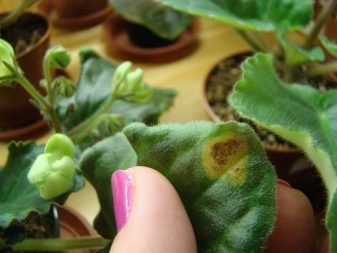Description of violets Buckeye Seductress

Violet Buckeye Seductress pleases with its solemn appearance. During the flowering period, it is covered with a thick cap of peduncles, the leaves stand out with a beautiful white fringe. The quality of flowering and the intensity of the color depend on the conditions that the grower will create for the flower.

Description of the variety
The lilac-blue flowers of this violet are not large, but on the bush they are formed in great abundance. From the characteristics of the variety, a wide green border of the flower can be distinguished. Depending on the subspecies, the shade can be either light purple or rather bright and saturated. When the flower grows old, it starts to deteriorate from the middle, then the petals slowly dry out.
Foliage is formed in large rosettes, it has a rich shade of green. Even during the dormant period, when the violet has only leaves, it looks elegant. After planting, the first flowering appears in a year. This variety does not need a lot of light, but it must be distributed evenly.
You can put the pot under a lamp with artificial light, it will be enough for year-round flowering.


Conditions
A window facing north or east is ideal for violets. Its leaves always stretch towards the light, so you need to turn the pot regularly so that the bush grows evenly in width. Violets also bloom very well under daylight. If the plant has thick leaves and long stems, then it is not getting enough sunlight. Low-growing bushes with short stems and small, wrinkled leaves, on the other hand, receive too much sun.
To be healthy and bloom, a violet needs 14 to 16 hours of bright ambient or artificial light every day. Plants also need to stay in the dark for 8 hours. These flowers are picky about temperature. At night, she should be indoors between 18 and 21 degrees, during the day the temperature can be higher. If the windows are not sufficiently insulated, it is necessary to move the flowers to the shelf on a cold night.
Violets darken and wilt if it gets too cold, but they don't like intense heat either. Air conditioning, higher humidity and an optimal amount of light are what the plant needs. Flowers need high humidity, this is the only way they will bloom. Professionals use humidifiers and trays of stones and water.
It is important to prevent the appearance of drops on the leaves, otherwise problems with fungal infections will begin.


Priming
The PH of the soil should be at the level of 5.8-6.2. It needs to be well drained as these plants are sensitive to moist soil. Ready-made mixtures are an ideal solution, since all proportions in them are observed by the manufacturer. A grower can make his own soil by mixing in equal parts peat moss, perlite or vermiculite and river sand. But you can't take sand from the beach, because it is harmful and contains many substances that will simply kill the violet. Before use, the soil must be sterilized by heating to 82 ° C for 30 minutes.


Fertilizers
The standard fertilizer formula for violets is 14-12-14 NPK. Most experts recommend using a fully water soluble fertilizer so that you can water and fertilize at the same time. It is better to apply fertilizing more often at a lower concentration than to burn the roots.

Watering
Loose potting soil with a high organic content is a good breeding ground for violets. Experts disagree on the best way to water these colorful plants, which prefer an evenly moist soil. You can moisten the soil from above or below by placing the pot in a bowl of water or using a wick.


Reproduction
Beginners are always advised to use leaves or flower stalks as breeding material for violets. The thing is that in this way you can create as many plants as you like, while preserving the properties of the mother. The process is very simple.
- First, a knife or blade is processed with which the cut will be made. Use alcohol or a dissolved activated carbon tablet.
- Shoots from the third row are suitable as a good planting material. Too young leaves do not take root, old ones have a stiff stem, it also gives roots poorly.
- Perlite is considered a better germination medium, since it retains moisture, but does not create conditions of high humidity.
- After planting and watering, the leaf can be hidden under a plastic cup or film, so it will germinate faster, but you need to ventilate it every day.
- After a few weeks, a rosette will appear, when there are about four leaves, you can transplant into another pot with soil.


Diseases and insects
Growing violets is an enjoyable hobby for many people. Plants will bloom almost constantly with proper care and timely pest control. By paying close attention to potting soil, moisture, watering and fertilization, the grower will be rewarded with a healthy plant and beautiful flowering.
Violets can be affected by fungal, bacterial and viral diseases, which often lead to the death of the flower. The best remedy for problems is fungicides. Insecticides help against insects, but bacterial lesions are not cured.
Aphids, bugs, ticks, thrips are insects that the grower has to deal with most often. They can be removed with a decoction of onion peels or simply with a warm shower. Root rot requires more attention from the florist than powdery mildew or rust.
Since simple processing will not be enough, you need to change the pot, soil and cut off damaged roots.


How to grow a violet from a leaf is described in the next video































The comment was sent successfully.